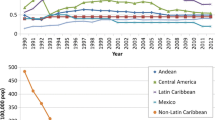Abstract
Three decades after the first reported cases of AIDS we have within our reach sufficient evidence to substantially alter the HIV epidemic at a country level regardless of mode of transmission of HIV. There are a growing number of countries demonstrating control of the epidemic. Human rights violations and/or legislation relating to sexual orientation, status of minors, injecting drug use and sex work together with stigma and discrimination remain key barriers to knowledge of HIV status and access to appropriate services. The use of anti-retrovirals prophylactically to reduce sexual and vertical transmission and systemically to treat infected infants and adults is central to the optimism in responses to the epidemic. In the current fiscal climate careful thought needs to be given to how to efficiently optimise combinations of what is available to have the biggest impact in the context of limited human and infrastructure resources.
Similar content being viewed by others
References
Hankins C. Overview of the current state of the epidemic. Curr HIV/AIDS Rep. 2013.
Abdool Karim Q, Kharsany ABM, Frohlich JA, Werner L, Mlotshwa M, Madlala BT, et al. HIV incidence in young girls in KwaZulu-Natal, South Africa-public health imperative for Their inclusion in HIV biomedical intervention trials. AIDS Behav. 2012. doi:10.1007/s10461-012-0209-y
Beyrer C, Baral SD, Van Griensven F, Goodreau SM, Chariyalertsak S, Wirtz AL, et al. Global epidemiology of HIV infection in men who have sex with men. Lancet. 2012;380:367–77.
Wu Z, Shi CX, Detels R. Addressing injecting drug use in Asia and Eastern Europe. Curr HIV/AIDS Rep. 2013 Feb 28. [Epub ahead of print].
Kasedde S, Luo C, McClure C, Chandan U. Reducing HIV and AIDS in adolescents: opportunities and challenges. Curr Reports. 2013.
Baeten J, Grant B. Use of antiretrovirals for HIV prevention: what do we know and what don’t we know? Curr HIV/AIDS Rep. 2013 Mar 14. [Epub ahead of print].
McNairy M, Cohen M, El Sadr W. Antiretroviral therapy for prevention is a combination strategy. Curr HIV/AIDS Rep. 2013 Jan 31. [Epub ahead of print].
Bor J, Herbst AJ, Newell M-L, Bärnighausen T. Increases in adult life expectancy in rural South Africa: valuing the scale-up of HIV treatment. Science. 2013;339(6122):961–5. doi:10.1126/science.1230413
Tanser F, Bärnighausen T, Grapsa E, Zaid J, Newell M-L. High coverage of ART associated with decline in risk of HIV acquisition in rural KwaZulu-Natal, South Africa. Science. doi:10.1126/science.1228160
Chi BH, Stringer JSA, Moodley D. Antiretroviral drug regimens to prevent mother-to-child transmission of HIV: a review of scientific, program, and policy advances for sub-Saharan Africa. Curr HIV/AIDS Rep. 2013 Feb 27. [Epub ahead of print].
Vermund SH, Hayes R. Combination prevention: new hope for stopping the epidemic. Curr HIV/AIDS Rep. 2013 Mar 1. [Epub ahead of print].
Cherutich P, Bunnell R, Mermin J. HIV testing: current practice and future directions. Curr Reports. 2013.
Persaud D, Gay H, Ziemniak C, Chen YH, Piatak M, Chun T-W, Strain M, Richman D, Luzuriaga K. Functional HIV cure after very early ART of an infected infant. 20th Conference of retroviruses and opportunistic infections. Atlanta, GA. Paper #48LB.
Elliott J, Solomon A, Wightman F, Smith M, Palmer S, Prince M, Watson J, Hoy J, McMahon J, Lewin S. The safety and effect of multiple doses of Vorinostat on HIV transcription in HIV+ patients receiving cART. 20th Conference of retroviruses and opportunistic infections. Atlanta, GA. Paper #50LB.
Sáez-Cirión A, et al. Post-treatment HIV-1 controllers with a long-term virological remission after the interruption of early initiated antiretroviral therapy: ANRS VISCONTI Study. PLoS Pathog. 9(3):e1003211.
Author information
Authors and Affiliations
Corresponding author
Rights and permissions
About this article
Cite this article
Abdool Karim, Q. The Global HIV Epidemic: Current Status and Challenges. Curr HIV/AIDS Rep 10, 111–112 (2013). https://doi.org/10.1007/s11904-013-0160-1
Published:
Issue Date:
DOI: https://doi.org/10.1007/s11904-013-0160-1




